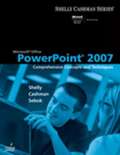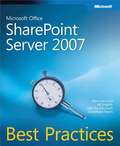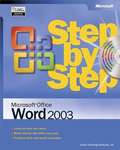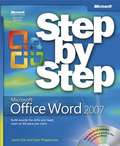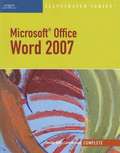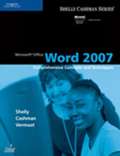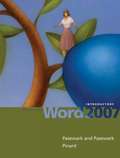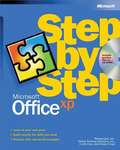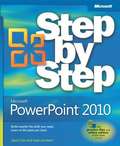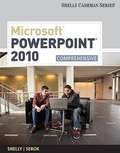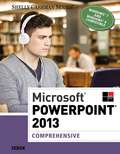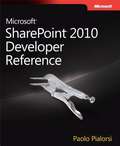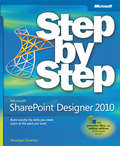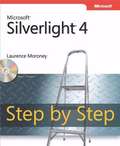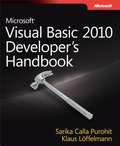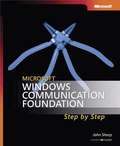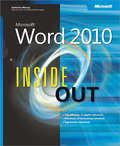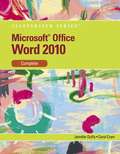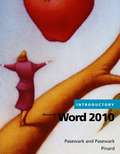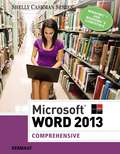- Table View
- List View
Microsoft® Office PowerPoint® 2007: Comprehensive Concepts and Techniques
by Gary B. Shelly Thomas J. Cashman Susan L. SebokIn Microsoft PowerPoint 2007: Comprehensive Concepts and Techniques you?ll find features that are specifically improve retention, and prepare readers for future success. Our trademark step-by-step, screen-by-screen approach now encourages users to expand their understanding of the PowerPoint 2007 software through experimentation, exploration, and planning ahead.
Microsoft® Office SharePoint® Server 2007 Best Practices
by Bill English Ben CurryGet field-tested best practices and proven techniques for designing, deploying, operating, and optimizing Microsoft Office SharePoint Server 2007 and Windows SharePoint Services 3.0. Part of the new Best Practices series for IT professionals from Microsoft Press®, this guide is written by leading SharePoint MVPs and Microsoft SharePoint team members who've worked extensively with real-world deployments and customers. You'll find out how to deploy the software, design your environment, manage content, analyze and view data, perform disaster recovery, monitor performance, and more. You'll learn how to create SharePoint sites that help your organization collaborate, take advantage of business insights, and improve productivity--with practical insights from the experts.
Microsoft® Office Word 2003 Step by Step
by Online Training SolutionsExperience learning made easy--and quickly teach yourself how to use the word processing power in Word 2003. With STEP BY STEP, you can take just the lessons you need, or work from cover to cover. Either way, you drive the instruction--building and practicing the skills you need, just when you need them! Turn your ideas into impressive documents--from memos and form letters to Web pages and complex reports Learn easy formatting techniques that add impact to your communications Embellish text with pictures, animations, drawings, and other effects Share documents for review with greater control over revisions and changes Organize your information with diagrams, tables, and charts Prepare for the Microsoft Office Specialist exam Practice your skills using the files on CD! Your Microsoft Office System Reference Pack on CD includes: Twenty-five templates straight from the Microsoft Office team Microsoft Office System Quick Reference eBook Insider's Guide to Microsoft Office OneNote 2003 eBook--describes new notetaking features in Office Microsoft Computer Dictionary, Fifth Edition, eBook--10,000+ entries! Introducing the Tablet PC eBook Complete STEP BY STEP eBook Skill-building practice files A Note Regarding the CD or DVD The print version of this book ships with a CD or DVD. For those customers purchasing one of the digital formats in which this book is available, we are pleased to offer the CD/DVD content as a free download via O'Reilly Media's Digital Distribution services. To download this content, please visit O'Reilly's web site, search for the title of this book to find its catalog page, and click on the link below the cover image (Examples, Companion Content, or Practice Files). Note that while we provide as much of the media content as we are able via free download, we are sometimes limited by licensing restrictions. Please direct any questions or concerns to booktech@oreilly.com.
Microsoft® Office Word 2007 Step by Step
by Joan Lambert Joyce CoxThe smart way to learn the latest version of Office Word 2007-one step at a time! Build exactly the skills you need by working at your own pace through easy-to-follow lessons.
Microsoft® Office Word 2007 Step by Step
by Joan Lambert Joyce CoxExperience learning made easy--and quickly teach yourself how to create impressive documents with Word 2007. With Step By Step, you set the pace--building and practicing the skills you need, just when you need them! Apply styles and themes to your document for a polished look Add graphics and text effects--and see a live preview Organize information with new SmartArt® diagrams and charts Insert references, footnotes, indexes, a table of contents Send documents for review and manage revisions Turn your ideas into blogs, Web pages, and more Your all-in-one learning experience includes: Files for building skills and practicing the book's lessons Fully searchable eBook Bonus quick reference to the Ribbon, the new Microsoft Office interface Windows Vista® Product Guide eBook--plus more resources and extras on CD A Note Regarding the CD or DVD The print version of this book ships with a CD or DVD. For those customers purchasing one of the digital formats in which this book is available, we are pleased to offer the CD/DVD content as a free download via OReilly Medias Digital Distribution services. To download this content, please visit OReillys web site, search for the title of this book to find its catalog page, and click on the link below the cover image (Examples, Companion Content, or Practice Files). Note that while we provide as much of the media content as we are able via free download, we are sometimes limited by licensing restrictions. Please direct any questions or concerns to booktech@oreilly.com.
Microsoft® Office Word 2007, Illustrated, Complete
by Carol Cram Jennifer DuffyThis Microsoft Office 2007 Illustrated Series book covers the essential information that you need to know about how to use Microsoft Word 2007. Our signature two-page spread design has been updated and refreshed to take full advantage of the new features of the Office 2007 software. This practical, easy to navigate book provides you with the essential knowledge you need to succeed at both work and beyond.
Microsoft® Office Word 2007: Comprehensive Concepts and Techniques
by Gary B. Shelly Thomas J. Cashman Misty E. VermaatMicrosoft Office Word 2007: Comprehensive Concepts and Techniques provides a project-based, step-by-step approach to successfully teach students Microsoft Word 2007 skills.
Microsoft® Office Word 2007: Introductory Course
by Beth Pasewark Wadsworth Carolyn Denny Pasewark Jan Pasewark Stogner Katherine T. Pinard Scott G. Pasewark William R. PasewarkIntroduce your students to Microsoft Office Word 2007 with the books teachers know and trust from the award-winning authors, Pasewark and Pasewark along with contributing authors Rachel Biheller Bunin, Jessica Evans, Katherine T. Pinard, and Robin M. Romer. This text includes features that make learning easy and enjoyable, yet challenging for learners. Students will be engaged with activities that range from simulations to case studies that challenge and sharpen problem-solving skills.
Microsoft® Office XP Step by Step
by Curtis Frye Online Training Solutions Kristen CrupiExperience learning made easy--and quickly teach yourself how to use the complete suite of Microsoft® Office XP applications. With STEP BY STEP, you can take just the lessons you need or work from cover to cover. Either way, you drive the instruction--building and practicing the skills you need, just when you need them! WORD: Create and publish great-looking documents quickly and easily EXCEL: Develop easy-to-use spreadsheets and perform calculations ACCESS: Build your own databases for better decision making POWERPOINT®: Produce and deliver compelling presentations FRONTPAGE®: Get yourself--or your company--on the Web fast by constructing your own site PUBLISHER: Create professional-quality marketing materials--without being a designer OUTLOOK®: Manage your e-mail communications and calendar
Microsoft® PowerPoint® 2010 Plain & Simple
by Nancy MuirGet the guide that makes learning Microsoft PowerPoint 2010 plain and simple! This full color, no-nonsense book shows you the quickest ways to solve problems and learn the tools, using easy-to-follow steps and concise, straightforward language. You'll discover new and exciting ways to create and share dynamic presentations with any audience. Here's WHAT you'll learn: Create dynamic presentations for your audience Include charts, tables, clip art, and other graphics Add video clips and CD music Animate slide and add transition effects Edit and polish your presentations with ease Create speaker notes and record narration Here's HOW you'll learn it: Jump in whenever you need answers Easy-to-follow STEPS and SCREENSHOTS show exactly what to do Handy TIPS teach new techniques and shortcuts Quick TRY THIS! exercises help apply what you learn right away
Microsoft® PowerPoint® 2010 Step by Step
by Joan Lambert Joyce CoxExperience learning made easy-and quickly teach yourself how to create dynamic presentations with PowerPoint 2010. With STEP BY STEP, you set the pace-building and practicing the skills you need, just when you need them! Topics include creating great-looking slides using templates or your own designs; creating sophisticated charts and diagrams; using animation, sound, and other special effects; creating presentations simultaneously with others over the Web; delivering presentations; and other core topics.
Microsoft® PowerPoint® 2010, Comprehensive
by Gary B. Shelly Susan L. SebokMicrosoft Office PowerPoint 2010: Comprehensive provides a project-based, step-by-step approach to successfully teach students Microsoft PowerPoint 2010 skills.
Microsoft® PowerPoint® 2013: Comprehensive
by Susan L. SebokIntroduce your students to the latest that Microsoft Office has to offer with the new generation of Shelly Cashman Series books! For the past three decades, the Shelly Cashman Series has effectively introduced computer skills to millions of students. With MICROSOFT POWERPOINT 2013, we're continuing our history of innovation by enhancing our proven pedagogy to reflect the learning styles of today's students. In this text you'll find features that are specifically designed to engage students, improve retention, and prepare them for future success. Our trademark step-by-step, screen-by-screen approach now encourages students to expand their understanding of MICROSOFT POWERPOINT 2013 through experimentation, critical thought, and personalization. With these enhancements and more, the Shelly Cashman Series continues to deliver the most effective educational materials for you and your students.
Microsoft® SharePoint® 2010 Developer Reference
by Paolo PialorsiBuild robust solutions for business collaboration--using SharePoint 2010 Sharpen your development skills with this practical reference to Microsoft SharePoint Foundation 2010 and Microsoft SharePoint Server 2010. Written by enterprise-development expert Paolo Pialorsi, this book shows you how to develop real-world business solutions, using techniques to extend and customize the SharePoint environment with Microsoft Visual Studio® 2010. Discover how to: Write robust code for SharePoint solutions using the Server Object Model Use the Client Object Model to build Microsoft Silverlight® and JavaScript applications for SharePoint Extend the UI to customize menus, ribbons, and controls for intranets, extranets, and Internet sites Query and manage items in SharePoint lists using the LINQ-to-SharePoint provider Develop custom workflows using Visual Studio 2010 or SharePoint Designer 2010 Delve into advanced solutions, such as connectable Web Parts and asynchronous programming Create security-enhanced code for SharePoint using sandboxed solutions Get code samples on the web For system requirements, see the Introduction.
Microsoft® SharePoint® 2010 Plain & Simple
by Chris Beckett Johnathan LightfootLearn the simplest ways to get things done with Microsoft® SharePoint® 2010! Here's WHAT You'll Learn Manage and share team information in one location Use project task lists to organize people and processes Create libraries for documents, media, slides, and more Work seamlessly with Microsoft Office Find content quickly with the Search Center Add SharePoint blogs, wikis, and personal sites Here's HOW You'll Learn It Jump in whenever you need answers Easy-to-follow STEPS and SCREENSHOTS show exactly what to do Handy TIPS teach new techniques and shortcuts Quick TRY THIS! exercises help apply what you learn right away
Microsoft® SharePoint® Designer 2010 Step by Step
by Penelope CoventryThe smart way to build applications with Microsoft® SharePoint® Designer 2010 -- one step at a time! Experience learning made easy -- and quickly teach yourself how to create SharePoint 2010 applications and workflows with Microsoft® SharePoint® Designer 2010. With Step by Step, you set the pace -- building and practicing the skills you need, just when you need them! Design solutions to meet your business scenario -- without code Customize lists, libraries, and SharePoint site pages Use Web Parts to display, edit, and modify list item data Access data from a variety of external sources Create workflows to automate business processes Use master pages and CSS to control how sites work Your Step by Step digital content includes: All the books practice files -- ready to download and put to work. Fully searchable online edition of this book -- with unlimited access on the Web. The print version of this book includes free digital content online. To download, please visit O'Reilly's web site, search for the title of this book to find its catalog page, and click on the link below the cover image (Examples, Companion Content, or Practice Files). Note that while we provide as much of the media content as we are able via free download, we are sometimes limited by licensing restrictions. Please direct any questions or concerns to booktech@oreilly.com.
Microsoft® Silverlight® 4 Step by Step
by Laurence MoroneyTeach yourself how to build rich Internet applications with Silverlight 4--one step at a time. With this practical, learn-by-doing tutorial, you'll learn how to create interactive user interfaces for the Web and the newest version of Windows Phone by mastering the essential tools and techniques for Silverlight. Install the tools you need and build your first Silverlight application Get up to speed on Silverlight 4 features, including out-of-browser support, webcam, and microphone Develop Web applications with Silverlight that work across browsers and devices Engage users with animation, video, layout, vector graphics, and 3D effects Learn how to build and deploy simple applications for Windows Phone 7 Create Windows Phone features such as Input Scope, Orientation, and the Application Bar Your online learning resources include: Practice exercises Code samples Fully searchable ebook A Note Regarding the CD or DVD The print version of this book ships with a CD or DVD. For those customers purchasing one of the digital formats in which this book is available, we are pleased to offer the CD/DVD content as a free download via O'Reilly Media's Digital Distribution services. To download this content, please visit O'Reilly's web site, search for the title of this book to find its catalog page, and click on the link below the cover image (Examples, Companion Content, or Practice Files). Note that while we provide as much of the media content as we are able via free download, we are sometimes limited by licensing restrictions. Please direct any questions or concerns to booktech@oreilly.com.
Microsoft® Visual Basic® 2010 Developer's Handbook
by Klaus Löffelmann Sarika Calla PurohitYour expert guide to building modern applications with Visual Basic 2010 Take control of Visual Basic 2010--for everything from basic Windows® and web development to advanced multithreaded applications. Written by Visual Basic experts, this handbook provides an in-depth reference on language concepts and features, as well as scenario-based guidance for putting Visual Basic to work. It's ideal whether you're creating new applications with Visual Basic 2010 or upgrading projects built with an earlier version of the language. Discover how to: Use Visual Basic 2010 for Windows Forms and Windows Presentation Foundation projects Build robust code using object-oriented programming techniques, such as classes and types Work with events and delegates--and add your own events to custom classes Program arrays, collections, and other data structures in the Microsoft .NET Framework Solve problems quickly and easily using My namespace in Visual Basic Dive into Microsoft LINQ, including LINQ to XML and LINQ to Entities Tackle threading, multitasking, and multiprocessor development and debugging
Microsoft® Windows® Communication Foundation Step by Step
by John SharpTeach yourself the essentials of Windows Communication Foundation--one step at a time. With this practical tutorial, you get hands-on guidance for creating the Web services you need to implement robust business applications for Windows. Discover how to: Build and host a Web service Design service contracts and data contracts Maintain state information and support transactions Programmatically configure bindings and endpoints Use load-balancing and perform content-based message routing Implement message encryption, authentication, authorization Optimize performance with service throttling, encoding, and streaming Implement asynchronous operations, oneway methods, and events Create services that interoperate with ASP.NET and COM+ CD features: Files for practice exercises Code samples Fully searchable eBook A Note Regarding the CD or DVD The print version of this book ships with a CD or DVD. For those customers purchasing one of the digital formats in which this book is available, we are pleased to offer the CD/DVD content as a free download via O'Reilly Media's Digital Distribution services. To download this content, please visit O'Reilly's web site, search for the title of this book to find its catalog page, and click on the link below the cover image (Examples, Companion Content, or Practice Files). Note that while we provide as much of the media content as we are able via free download, we are sometimes limited by licensing restrictions. Please direct any questions or concerns to booktech@oreilly.com.
Microsoft® Word 2010 Inside Out
by Katherine MurrayYou're beyond the basics with Word, so dive right in and really put your documents to work! This supremely organized reference packs hundreds of timesaving solutions, troubleshooting tips, and workarounds. It's all muscle and no fluff. Discover how the experts tackle Word 2010 -- and challenge yourself to new levels of mastery. Master the tools to expertly organize, edit, and present your content Craft professional-looking documents with Themes, Quick Style Sets, and Building Blocks Add visual impact with SmartArt® diagrams, charts, pictures, and drawings Organize and clarify content with effective tables and charts Use cross-references, tables of contents, and indexes in your complex documents Produce Web sites and publish blogs directly from Word Coauthor and collaborate on documents in real time -- and help keep them secure Customize documents with macros, content controls, and other automation features Your book -- online! Get your fully searchable online edition -- with unlimited access on the Web.
Microsoft® Word 2010 Plain & Simple
by Katherine MurrayGet the guide that makes learning Microsoft Word 2010 plain and simple! This full color, no-nonsense book shows you the quickest ways to solve a problem or learn new skills, using easy-to-follow steps and concise, straightforward language. You'll create professional-quality documents in no time. Here's WHAT you'll learn: Create professional-looking documents with ease Organize, edit, and format text Apply themes, styles, and other design elements Work with graphics, tables, and charts Take advantage of pre-built templates, or make your own Edit a document with others simultaneously -- online Here's HOW you'll learn it: Jump in whenever you need answers Easy-to-follow STEPS and SCREENSHOTS show exactly what to do Handy TIPS teach new techniques and shortcuts Quick TRY THIS! exercises help apply what you learn right away
Microsoft® Word 2010, Illustrated, Complete
by Carol Cram Jennifer DuffyLoved by instructors for its visual and flexible way to build computer skills, the Illustrated Series is ideal for teaching Microsoft Office Word 2010 to both computer rookies and hotshots. Each two-page spread focuses on a single skill, making information easy to follow and absorb. Large, full-color illustrations represent how the students' screen should look. Concise text introduces the basic principles of the lesson and integrates a case study for further application.
Microsoft® Word 2010, Introductory
by Beth Pasewark Wadsworth Carolyn Denny Pasewark Jan Pasewark Stogner Katherine T. Pinard Scott G. Pasewark William R. PasewarkMicrosoft Word 2010 Introductory, part of the Origins Series, is designed for beginning users of Microsoft Office 2010. This self-paced, step-by-step book with corresponding screenshots makes learning easy and enjoyable. Students will learn the new features of excel through a variety of activities, simulations, and case studies. End-of-lesson exercises reinforce the skills covered in each lesson.
Microsoft® Word 2013: Comprehensive
by Misty E. VermaatIntroduce your students to the latest that Microsoft Office has to offer with the new generation of Shelly Cashman Series® books! For the past three decades, the Shelly Cashman Series has effectively introduced computer skills to millions of students. With MICROSOFT WORD 2013, we're continuing our history of innovation by enhancing our proven pedagogy to reflect the learning styles of today's students. In this text you'll find features that are specifically designed to engage students, improve retention, and prepare them for future success. Our trademark step-by-step, screen-by-screen approach now encourages students to expand their understanding of MICROSOFT WORD 2013 through experimentation, critical thought, and personalization. With these enhancements and more, the Shelly Cashman Series® continues to deliver the most effective educational materials for you and your students.
